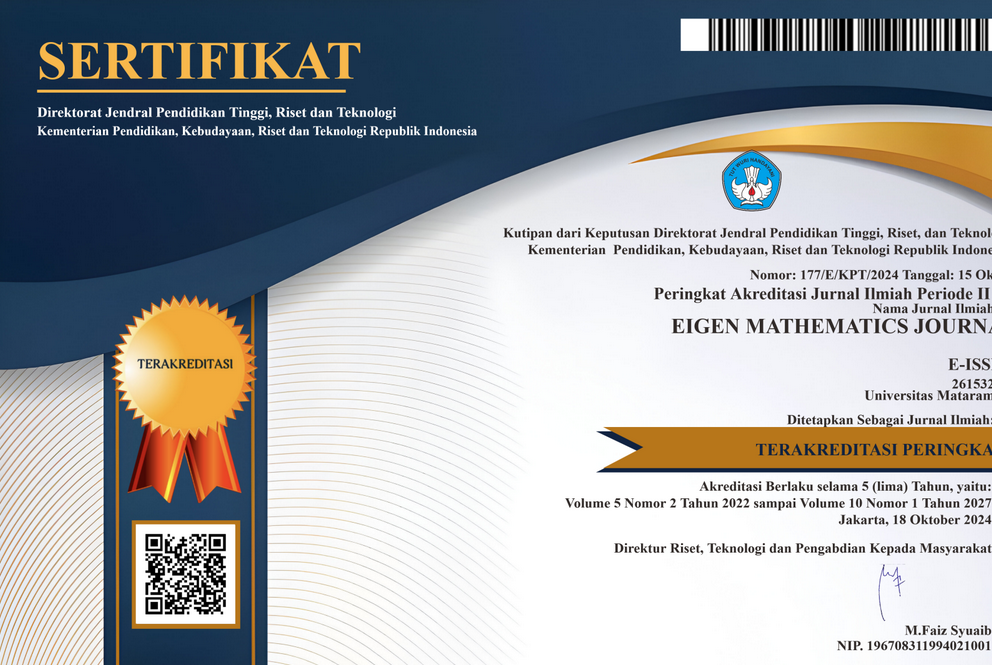Modeling of the Spread of Malaria in the Bangka Belitung Islands Province Using the SEIR Method
DOI:
https://doi.org/10.29303/emj.v7i1.189Keywords:
Malaria, SEIR, ModelAbstract
Malaria is an infectious disease caused by plasmodium through the bite of the Anopheles sp. female mosquito. (Roach, 2012). Malaria disease which hit the Bangka Belitung Islands Province in 2005 experienced a spike, reaching 36,901 people out of 981,573 residents and claimed the lives of 12 local residents. In 2011, the Bangka Belitung Islands Province was declared an endemic area for malaria. This research aims to model and interpret the spread of malaria using the SEIR model and predict the spread of malaria using parameter estimates. The steps in analyzing the SEIR model on the spread of malaria are making assumptions, forming a SEIR model, determining the equilibrium point and analyzing the stability of the equilibrium point, determining the basic reproduction number, and carrying out a simulation of the SEIR model that has been obtained. The SEIR model is classified into 4 classes, namely Susceptible (susceptible individuals), Exposed (individuals who have symptoms), Infected (infected individuals), and Recovered (recovered individuals). The data used in this research is data on the number of Susceptible, Exposed, Infected, and Recovered malaria cases in 2022 obtained from the Bangka Belitung Islands Provincial Health Service. The SEIR mathematical model is used to calculate the equilibrium point and basic reproduction number. Based on the SEIR model simulation results, it was found that the susceptible population decreased from the 0th month to the 48th month. As for the exposed population, there were 9,623 people in month 0, but in this condition the population decreased drastically per month. Furthermore, for the infected population there were 129 people in month 0, but in this condition the number of infected decreased drastically per month along with the decrease in the exposed population. For individuals who recovered, there was a increase from the 0th month to the 48th month.References
Alim, A., Adam, A., & Dimi, B. (2020). Prevalensi Malaria Berdasarkan Karakteristik Sosio Demografi. Jurnal Ilmiah Kesehatan, 19(01), 4–9. https://doi.org/10.33221/jikes.v19i01.399
Ashari, I.M.A., Arditama, P., Khoirunnisa, K. dan Kharis, M. 2021. Mathematical Modeling of Diabetes Mellitus Type 2 Due to Obesity from Food and Physical Inactivity. Nucleus Journal. 2(1), pp. 23–32. https://doi.org/10.37010/nuc.v2i1.259
Asmiani, Windusari, Y. and Hasyim, H. 2021. Analisis Strategi Pengendalian Vektor Malaria di Kabupaten Bangka Barat. Media Publikasi Promosi Kesehatan Indonesia (MPPKI). 4(4), pp. 545–553. https://doi.org/10.56338/mppki.v4i4.1827
Cahyaningsih, A., Putra, N.P., Pratama, A.P.E. dan Ramadhani, R. 2020. Model Prediksi Jumlah Kumulatif Kasus COVID-19 di Indonesia Menggunakan Metode Neural Network. Journal of Informatics, Information System, Software Engineering and Applications. 3(1), pp. 76–83. https://doi.org/10.20895/inista.v3i1.177
Diniyati, L.S. and Jayatmi, I. 2017. Prevalensi Malaria Berdasarkan Sosio Demografi. Jurnal Ilmiah Kesehatan. 16(1), pp. 14–22.
Eby. (2011). Bangka Belitung di Balik Ancaman Malaria. Pemuda Batavia. https://pemudabatavia.wordpress.com/2011/11/06/bangka-belitung-di-balik-ancaman-malaria/.
Hidayati, R., Faisal, dan Yulida, Y. 2017. Model Matematika pada Penyebaran Malaria di Kalimantan Selatan. Epsilon Jurnal Matematika Murni dan Terapan. 11(2), pp. 11–18.
Ihsan, H., Side, S. and Pagga, M. 2021. Pemodelan Matematika SEIRS pada Penyebaran Penyakit Malaria di Kabupaten Mimika. Journal of Mathematics Computations and Statistics. 4(1), p. 21.
RH, P. (2006). Malaria Melanda, 12 Warga Bangka-Belitung Meninggal Dunia. ANTARA. https://www.antaranews.com/berita/31460/malaria-melanda-12-warga-bangka-belitung-meninggal-dunia. Diakses tanggal 26 Januari 2023.
Roach, R.R. 2012. Malaria. Tropical Pediatrics: A Public Health Concern of International Proportions: Second Edition. 4(2), pp. 287–297.
Side, S., Sanusi, W., & Setiawan, N. F. (2016). Analisis dan Simulasi Model SITR pada Penyebaran Penyakit Tuberkulosis di Kota Makassar Analysis and Simulation Of SITR Model on Tuberculosis in Makassar City. Jurnal Sainsmat, V(2), 191–204. https://ojs.unm.ac.id/sainsmat/article/download/6448/3681
Sulistioningtias, E. S., & Lestari, D. (2018). Pemodelan Matematika Penyebaran Penyakit Malaria dengan Model SEIR. Jurnal Pendidikan Matematika Dan Sains, 7(5), 1–11. http://journal.student.uny.ac.id/ojs/index.php/math/article/view/1244
Downloads
Published
How to Cite
Issue
Section
License

This work is licensed under a Creative Commons Attribution-NonCommercial-ShareAlike 4.0 International License.
All articles published in the Eigen Mathematics Journal will be available for free reading and downloading. The license applied to this journal is Creative Commons Attribution-Non-Commercial-Share Alike (CC BY-NC-SA).
Most read articles by the same author(s)
- Baiq Desy Aniska Prayanti, Maxrizal Maxrizal, Proving The Fermat Last Theorem for Case q≤n , EIGEN MATHEMATICS JOURNAL: Vol. 5 No. 2 Desember 2022
- Irfaliani Alviari, Ines Monika, Sarina Sarina, Lianda Saputra, Baiq Desy Aniska Prayanti, Implementation of Fuzzy Logic Using The Tsukamoto Method to Forecast Gold Price in Indonesia , EIGEN MATHEMATICS JOURNAL: Vol. 8 No. 1 (2025): June






